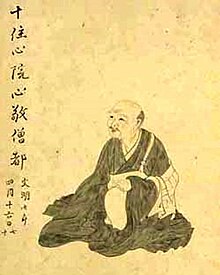Shinkei | |
|---|---|
 Shinkei | |
| Native name | 心敬 |
| Born | 1406 Kii Province (now Wakayama, Wakayama Prefecture), Japan |
| Died | April 14, 1475 (aged 68–69) Ōyama, Sagami Province, Japan |
| Occupation | poet and priest |
| Language | Japanese |
| Nationality | Japanese |
| Genre | Tanka and renga poetry |
Shinkei (心敬, 1406 – 14 May 1475) [1] was a Japanese Buddhist priest and poet ( tanka and renga poetry).
Shinkei was born in Taisha, Kii Province (now Wakayama, Wakayama Prefecture) in 1406. He was a Buddhist priest at an early age and quickly rose to the rank of Daisōzu (大僧都, Senior Director). [2] [1]
He regarded poetry as the result of a religious way of life (shugyō). [3] For more than thirty years he remained a student with the poet Shōtetsu. His poems are based on the Japanese aesthetic ideal called yūgen (幽玄). [4] [2] He also wrote the poetic treatises Sasamegoto (ささめごと) in 1463 and Oi no kurigoto (老のくりごと) in 1471. [1] [3]
Shinkei died on 14 May 1475 in Ōyama, Sagami Province (now part of Kanagawa Prefecture).
Esperanza Ramirez-Christensen translated and annotated Shinkei's Sasamegoto under the title Murmured Conversations: A Treatise on Poetry and Buddhism by the Poet-Monk Shinkei ( Stanford University Press, 2008), which received the Japan–U.S. Friendship Commission Prize for the Translation of Japanese Literature in 2009. Ramirez-Christensen also published a book-length study on Shinkei's life and poetry titled Heart's Flower: The Life and Poetry of Shinkei (Stanford University Press, 1994). [5]
- ^ a b c 沢井耐三. "心敬". 朝日日本歴史人物事典 bei kotobank.jp (in Japanese). Asahi Shimbun Shuppan.
- ^ a b Carter, Steven D. (1993). Traditional Japanese Poetry. Stanford University Press. p. 289. ISBN 0-8047-2212-9.
- ^ a b Kleines Lexikon der Japanologie. Zur Kulturgeschichte Japans. Harrassowitz. 1995. p. 423. ISBN 978-3-447-03668-9.
- ^ Odin, Steve (2001). Artistic Detachment in Japan and the West: Psychic Distance in Comparative Aesthetics. University of Hawaiʻi Press. p. 112. ISBN 0-8248-2374-5.
- ^ Ramirez-Christensen, Esperanza (1994). Heart's Flower: The Life and Poetry of Shinkei. Stanford University Press. ISBN 9780804722537.
Shinkei | |
|---|---|
 Shinkei | |
| Native name | 心敬 |
| Born | 1406 Kii Province (now Wakayama, Wakayama Prefecture), Japan |
| Died | April 14, 1475 (aged 68–69) Ōyama, Sagami Province, Japan |
| Occupation | poet and priest |
| Language | Japanese |
| Nationality | Japanese |
| Genre | Tanka and renga poetry |
Shinkei (心敬, 1406 – 14 May 1475) [1] was a Japanese Buddhist priest and poet ( tanka and renga poetry).
Shinkei was born in Taisha, Kii Province (now Wakayama, Wakayama Prefecture) in 1406. He was a Buddhist priest at an early age and quickly rose to the rank of Daisōzu (大僧都, Senior Director). [2] [1]
He regarded poetry as the result of a religious way of life (shugyō). [3] For more than thirty years he remained a student with the poet Shōtetsu. His poems are based on the Japanese aesthetic ideal called yūgen (幽玄). [4] [2] He also wrote the poetic treatises Sasamegoto (ささめごと) in 1463 and Oi no kurigoto (老のくりごと) in 1471. [1] [3]
Shinkei died on 14 May 1475 in Ōyama, Sagami Province (now part of Kanagawa Prefecture).
Esperanza Ramirez-Christensen translated and annotated Shinkei's Sasamegoto under the title Murmured Conversations: A Treatise on Poetry and Buddhism by the Poet-Monk Shinkei ( Stanford University Press, 2008), which received the Japan–U.S. Friendship Commission Prize for the Translation of Japanese Literature in 2009. Ramirez-Christensen also published a book-length study on Shinkei's life and poetry titled Heart's Flower: The Life and Poetry of Shinkei (Stanford University Press, 1994). [5]
- ^ a b c 沢井耐三. "心敬". 朝日日本歴史人物事典 bei kotobank.jp (in Japanese). Asahi Shimbun Shuppan.
- ^ a b Carter, Steven D. (1993). Traditional Japanese Poetry. Stanford University Press. p. 289. ISBN 0-8047-2212-9.
- ^ a b Kleines Lexikon der Japanologie. Zur Kulturgeschichte Japans. Harrassowitz. 1995. p. 423. ISBN 978-3-447-03668-9.
- ^ Odin, Steve (2001). Artistic Detachment in Japan and the West: Psychic Distance in Comparative Aesthetics. University of Hawaiʻi Press. p. 112. ISBN 0-8248-2374-5.
- ^ Ramirez-Christensen, Esperanza (1994). Heart's Flower: The Life and Poetry of Shinkei. Stanford University Press. ISBN 9780804722537.